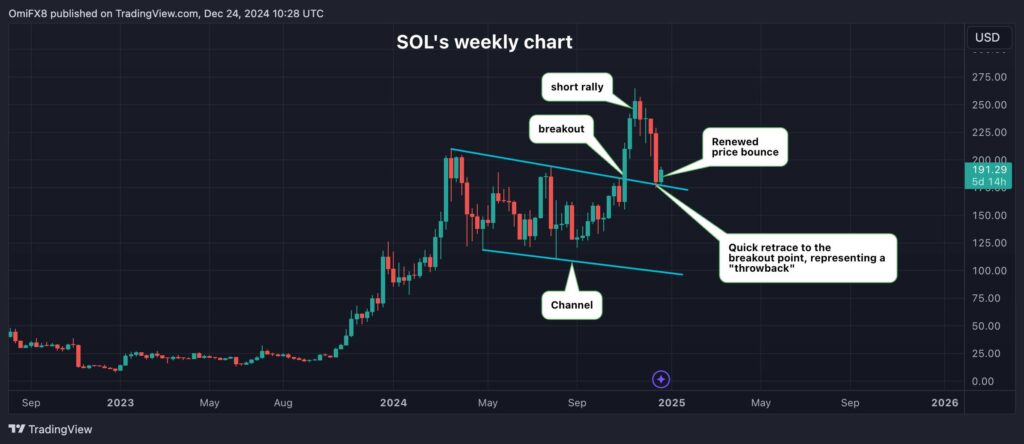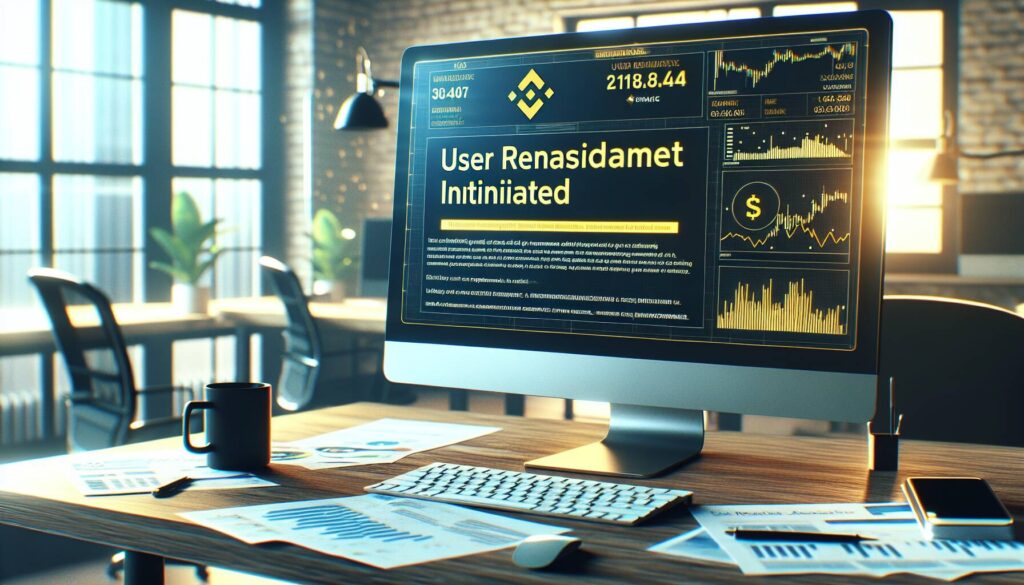In the world of trading, especially within fast-moving crypto markets, moments of opportunity can feel both thrilling and fleeting. If you’re a trader who missed Solana’s (SOL) initial breakout, you’re likely watching with eager caution as it retraces back to a well-recognized support level — a textbook “throwback” that technical analysts often celebrate.
This week, SOL rebounded after pulling back to a critical price zone that previously served as resistance. The area is defined by a descending trendline connecting the market highs from March and July of this year — but what makes this moment particularly exciting is that this same level has now flipped into support. Analysts often view this type of shift as a powerful signal confirming a shift in market sentiment, transforming previous hesitation into growing bullish momentum.
Here’s where it gets even more intriguing: this price action isn’t happening in isolation. It’s part of a larger technical structure, a descending channel stretching back months to March. Watching price break out beyond this channel in early November signaled the first spark of optimism, a moment closely followed by a brisk climb to 0. But as experienced traders know, markets rarely move in straight lines. Prices eventually pulled back, revisiting the breakout level last week in what technical analysis refers to as a “throwback.”
Why does this matter? Because throwbacks offer their own form of opportunity. It’s a chance to participate in the trend with potentially reduced risk compared to jumping in during the initial breakout. The textbook nature of SOL’s price movement right now — a well-defined breakout rally followed by a controlled retracement back to the breakout level — is precisely the sort of setup traders teach in trading workshops or reference in key texts on the subject.
Charles D. Kirkpatrick II and Julie R. Dahlquist, in their widely cited work “Technical Analysis: The Complete Resource for Financial Market Technicians,” describe throwbacks as moments that tend to be both brief and limited in scope — and, most importantly, laden with potential. For those who are monitoring without having taken action earlier, this type of retracement often provides what they call a “second chance” to enter a breakout-driven trend.
The fascinating thing about this retracement isn’t just that it’s technical; it’s also psychological. For many traders, life is full of “what-ifs” — the trades not taken, the missed breakouts. Watching SOL tracing back to the breakout zone is like being handed another opportunity, one imbued with clearer levels of risk and reward.
That’s what makes SOL’s current price behavior so gripping: it’s pulling traders back to the charts, nudging them to weigh their choices decisively as it tests the newly established support. Will this moment give rise to the next push higher toward new highs? Or will it falter, returning prices to their prior consolidation in the channel? For now, this throwback is providing everyone — from cautious onlookers to seasoned breakout traders — the kind of second chance that doesn’t often come easily in dynamic markets like crypto.
For breakout traders, moments like this are goldmines of strategic opportunity. When Solana (SOL) revisits its breakout level in such a controlled and textbook manner, the risk-to-reward profile becomes especially appealing. Why? Because a breakout retest like SOL’s offers a much clearer line in the sand for managing downside risk.
Unlike the initial breakout surge — where bulls jump in on momentum with stop-loss levels often farther away and less defined — a successful throwback gives traders a chance to enter at or near the breakout level. This level, now flipped into support, acts as a natural marker for invalidation. Simply put, if prices dip convincingly below this level, the bullish scenario weakens or fails entirely. Knowing precisely where that tipping point lies can be empowering for traders who dislike ambiguity in their strategies.
For example, someone entering at the throwback might place a well-defined stop-loss just a fraction below the breakout level. The rationale? If the market sinks to or below that point, it signals that the breakout has failed, minimizing further losses. This fine-tuned approach to risk management makes throwbacks sought after by traders looking to maximize gains while carefully controlling downside exposure.
Beyond risk control, throwbacks often reflect broader market dynamics at play, including the increased participation of market players. When prices revisit a breakout level, it often brings clarity — a price area where the market collectively “decides” whether previous resistance will now truly act as support. This testing and retesting act as qualifiers for the strength of the trend, and for traders, being on the right side of that decision can be immensely rewarding.
Another factor that makes SOL’s current setup so compelling is timing. Throwbacks tend to be short-lived, as they often occur just before fresh waves of bullish momentum take hold. This brief window isn’t just about technical patterns; it’s about psychology, too. Seeing prices stabilize and hold after a retracement often serves to rebuild confidence among hesitant buyers, potentially catalyzing the next leg up. In SOL’s case, this could mean a renewed push toward reclaiming recent highs — or even exceeding them.
For those who missed the breakout entirely, the current throwback represents what many refer to as a second-chance trade. Rarely do markets extend these lifelines in such an elegant fashion. It’s easy to feel regret about not catching that initial breakout rally to 0, but here’s the thing — trading isn’t about perfection. It’s about aligning opportunity with preparation. And SOL’s price action right now is doing its part, extending a hand to traders waiting on the sidelines.
If you’re feeling a mix of anticipation and hesitation, that’s natural. Throwbacks often come with this emotional tug-of-war. But what’s encouraging is the clarity of the setup — SOL is essentially “showing its hand” by reacting to its breakout level in a way that suggests ongoing buyer interest. Whether you’re a seasoned trader or someone newer to breakout strategies, moments like this underscore why staying patient and prepared can pay off.
Of course, there are no guarantees in markets. Not every throwback launches into a clean uptrend. Still, the structured opportunity SOL’s throwback is offering right now allows traders to define their entries, exits, and risk with surgical precision — and that alone is enough to warrant a closer look at this unfolding setup.
When it comes to understanding the intricacies of Solana’s (SOL) ongoing throwback, it’s not just about the numbers or the lines on a chart—it’s about human behavior. At its core, this pattern reveals how psychology and market dynamics intersect, creating opportunities that go beyond technical setups. If you’re watching SOL’s movements and trying to make sense of the next step, take comfort in knowing that you’re not alone. What’s playing out is a tapestry of emotions and decision-making shared among countless traders trying to balance fear, ambition, and logic.
Let’s start with what drives the throwback in the first place: profit-taking. When prices break out forcefully, as SOL did in November, early entry traders—those who jumped in as the breakout confirmed—are often the first to lock in gains. Why? Because human psychology leans toward certainty. The prospect of securing profits, especially when market volatility is high, often outweighs the desire to hold out for even greater rewards. It’s a natural reaction rooted in risk aversion, amplified in high-stakes markets like cryptocurrency.
This tendency to quickly take profits is one of the reasons why breakout rallies often pause or reverse, leading to retracements back to key levels. But something fascinating happens in this process—confidence doesn’t dissolve entirely. Instead, the same level that was once resistance transforms into support. This is where the magic of the throwback lies. Traders who might have been hesitant at first, or who felt they’d “missed the boat,” now see an opportunity to enter. The allure of a second chance can be just as powerful as the fear of missing out (FOMO) during the initial breakout.
To better understand this, consider prospect theory, which suggests that people make decisions based on potential gains or losses rather than the final outcome. The emotional weight of missing a breakout often compels traders to act when prices test the breakout level again. In the case of SOL, as prices retraced to the key support at the breakout point, it wasn’t just a technical pattern playing out—it was a psychological trigger inviting sidelined traders to finally take the leap. This added influx of buying interest helped reinforce the bounce and reestablished confidence among participants.
Moreover, throwbacks have a unique way of fortifying market sentiment. As prices stabilize around the breakout level, buyers who previously took profits may start to regret closing their positions too early. This “buyer’s remorse” can drive former profit-takers to reenter the market. Imagine the emotional pull of watching SOL climb from 3 back toward its highs—those who missed out wouldn’t want to make the same mistake twice. The result? A momentum-building feedback loop of renewed buying pressure.
Another psychological driver behind throwbacks is the collective need for validation. When prices test a breakout level and hold, it often signals to traders that the initial breakout wasn’t a fluke—it’s confirmation that the trend could be genuine. Validation reduces uncertainty, which is one of the biggest hurdles for hesitant market participants. This dynamic helps explain why throwbacks often transition quickly from consolidation to renewed upward momentum, as doubters convert into believers and buyers step in with growing conviction.
One might also view the throwback as a test of commitment. For the market to truly shift sentiment, the breakout level must withstand selling pressure and prove itself as a strong support zone. In SOL’s case, the ability of buyers to defend the breakout level, even as early sellers exited, is a testament to the underlying optimism surrounding the asset. Moments like these forge the foundation of strong trends, and while no one can predict the future, history shows that successful throwbacks often pave the way for the next leg of a bullish rally.
If you’re feeling a mix of hope and hesitation as you watch this setup unfold, it’s completely valid. Trading is as much about managing emotions as it is about analyzing patterns. But understanding the human behavior behind these movements can give you an edge. Rather than seeing the throwback as a simple retracement, consider it an invitation to participate in a larger story—one where traders collectively evaluate the strength of a trend and decide its next move.
So whether you’ve been watching from the sidelines or actively trading the breakout, know this: SOL’s throwback isn’t just a fleeting technical event. It’s a window into the psychology of markets, a shared moment where uncertainty and opportunity collide. For those who remain prepared and attuned to the dynamics unfolding in real-time, it’s an exciting chapter in Solana’s journey—one that could very well shape the next phase of its market narrative.
While the potential rewards of identifying and trading a bullish throwback pattern are enticing, it’s important to remember that no setup, no matter how textbook, comes with guaranteed success. Like any strategy, throwbacks carry their own set of risks, and being mindful of these pitfalls can make the difference between a calculated trade and an avoidable loss.
One of the most significant risks with a throwback is the possibility of the price failing to hold the breakout level as support. When this happens, the throwback pattern becomes invalidated, and the bullish setup collapses. In the case of Solana (SOL), if its price fails to sustain above the breakout level and drops back into the descending channel, it could signal a reversal in sentiment. Traders who entered during the throwback might find themselves caught on the wrong side of the trade as sellers regain control.
Breakouts and throwbacks are as much about market psychology as they are about technical patterns. A breakout is often accompanied by excitement and optimism, but when prices pull back and test the breakout level, hesitation and skepticism can re-enter the picture. If the bounce lacks strength — for example, if there’s insufficient buying momentum or volume to sustain a rally — it may indicate waning confidence among market participants. This could turn into a self-fulfilling prophecy, as traders begin exiting their positions out of fear, causing prices to fall further and confirming the invalidation of the pattern.
To mitigate the risks of trading a throwback, it’s essential to have a well-defined strategy. Setting a stop-loss below the breakout level is one of the most critical risk management tools in this scenario. While it can be uncomfortable to imagine getting stopped out, a well-placed stop-loss ensures that a single trade won’t wipe out your account. For example, in the case of SOL, traders might set their stop-loss just a percentage or two below the breakout level, ensuring that if the pattern fails, their downside exposure is limited.
Additionally, it’s crucial to keep an eye on volume. A successful throwback typically sees a rebound accompanied by strong buying interest. If SOL’s price appears to hold near the breakout level but volume remains low, it could be a warning sign that the bounce lacks conviction. Without sufficient participation from buyers, the price may struggle to sustain upward momentum, increasing the likelihood of a breakdown.
Another risk worth considering is external market conditions. Cryptocurrency markets, though influenced by technical levels, are deeply intertwined with broader market sentiment. A sudden shift in macroeconomic factors, regulatory developments, or adverse news specific to Solana could quickly derail the throwback setup, even if the technical structure appears sound. Traders need to remain agile and ready to adapt their strategies if conditions suddenly change.
It’s also important to recognize the emotional challenges that traders face during moments like these. Watching the price flirt with the breakout level can create a mix of excitement and anxiety. The fear of missing out (FOMO) might tempt some to enter impulsively, while others may be paralyzed by the fear of losing, causing them to avoid taking calculated risks altogether. In either case, emotions can cloud judgment, leading to poorly timed entries or exits that result in unnecessary losses.
One way to combat this emotional turbulence is to have a clear plan in place before entering the trade. By predefining your entry, stop-loss, and target levels, you can reduce the temptation to make decisions based on short-term fluctuations or emotional spikes. Aligning your expectations with the possibility of both success and failure allows you to approach the trade with a level-headed mindset, prepared for any outcome.
For traders considering SOL’s throwback, it’s imperative to remain patient. Let the price action confirm the support level and show clear signs of strength before committing. Jumping in too early or without sufficient confirmation can expose you to unnecessary risks. Conversely, waiting too long could mean missing the opportunity altogether. Striking this balance requires discipline and a willingness to trust your analysis.
Lastly, it’s important to remember that not every throwback holds, and that’s okay. In trading, no single trade defines your success — your long-term performance is what matters. By approaching setups like SOL’s throwback with an awareness of the risks and a commitment to sound risk management, you set yourself up for better outcomes over time, regardless of whether this specific trade delivers.
Trading is as much an art as it is a science. While technical patterns like throwbacks provide a framework for identifying opportunities, the real skill lies in managing risk and navigating uncertainty with clarity and resilience. If you approach SOL’s current setup with care and preparation, you’ll position yourself to adapt, whatever the outcome may be.

















